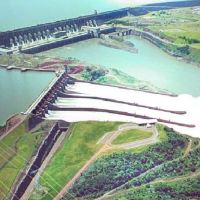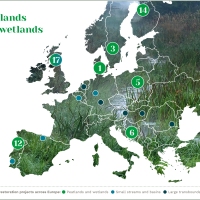Multiple pressures and the ecological status of European rivers

Floodplain on the River Ouse, Yorkshire. Image: alh1 | Flickr Creative Commons
Human activities have changed the flow, structure, ecology, chemistry and connectivity of rivers and lakes across Europe. Multiple pressures such as pollution, water abstraction and flow diversions are increasingly understood to act in combination, often reducing aquatic biodiversity and altering ecosystem functioning across the continent.
The EU Water Framework Directive is the ambitious water policy designed to reduce pressures and achieve a good ecological status for all European water bodies. However, assessing the multiple pressures acting on aquatic ecosystems, and understanding their combined impact on the ecological status of rivers and lakes is challenging, particularly at large scales. Understanding these interactions and impacts is crucial to the planning of effective water policy and management.
In this context, a recently published study provides an assessment of multiple human pressures and their relationships with ecological status for all European rivers. Writing in the (open-access) Nature: Scientific Reports journal, Bruna Grizzetti from the EC Joint Research Centre and colleagues estimate that only 38% of EU rivers reach ‘good’ or ‘high’ ecological status. 20% are rated as ‘bad’ or ‘poor’, whilst 42% are ‘moderate’.
The research team used ecological data collected across Europe, together with pressures including pollution, hydrological and hydromorphological alterations quantified in computer models. They found that good ecological status in rivers is most often associated with the presence of natural areas in floodplains. Floodplains can be important buffers of pollution, and give ‘room for the river’ to follow natural flow dynamics.
On the other hand, urbanisation and nutrient pollution are important pressure-predictors of ecological degradation. Urbanisation places a variety of pressures on aquatic systems, including water demands, hydrological and hydromorphological alterations, and wastewater releases; whilst nutrient pollution is widely-known as a catalyst for harmful eutrophication and cyanobacteria blooms.
Individual pressures have different geographies, according to the study. Nitrogen and phosphorous concentrations are highest in areas with intensive lowland agriculture in both Northern and Southern Europe, whilst urban run-off and water demand are more evenly distributed across populated regions of the continent. Persistent low flows are most common in Mediterranean regions of Spain, Portugal and Italy.
The most heavily modified flood plains are found in central Europe – particularly in Germany and the Netherlands – whilst the most ‘natural’ floodplain systems are found in Alpine regions and Scandinavia. Artificial and agricultural land cover is widespread across the continent (except for northern Scandinavia), and is most intensive in southern England, northern France, Netherlands and Germany.
Member states are required to conserve and restore their aquatic ecosystems to ‘good’ ecological status. The study found that only 32% of EU rivers currently meet this target. As a result, the research team used computer models to simulate the ecological effects of different management measures aimed at improving ecological status. They tested scenarios in which nitrogen pollution was reduced, and natural areas in floodplains increased, as these pressures were among the most significant variables explaining good ecological status.
The research team found that 4% of EU catchments with degraded rivers would achieve good ecological status by reducing nitrogen pollution and increasing natural areas in floodplains by 10%. Up to 8% of catchments could meet the policy target if the same measures were raised to 20%.
The predicted increase in good ecological status by simultaneously reducing nitrogen concentrations and enhancing natural floodplain areas is slightly higher than that achieved through changing the two pressures independently. This is known as a ‘synergistic’ multiple pressure effect, in which pressures interact to have ecological impacts greater than the sum of their individual parts.
As a result, the researchers write that maintaining natural floodplains and limiting nitrogen pollution should be key measures used to improve the ecological status of rivers and achieve Water Framework Directive goals.














